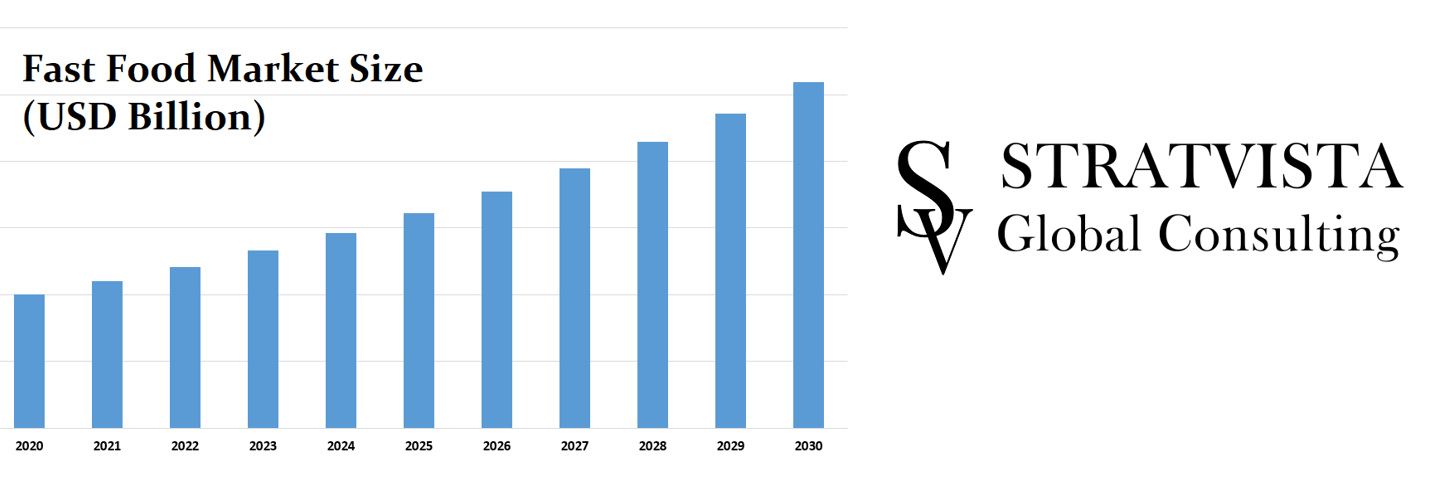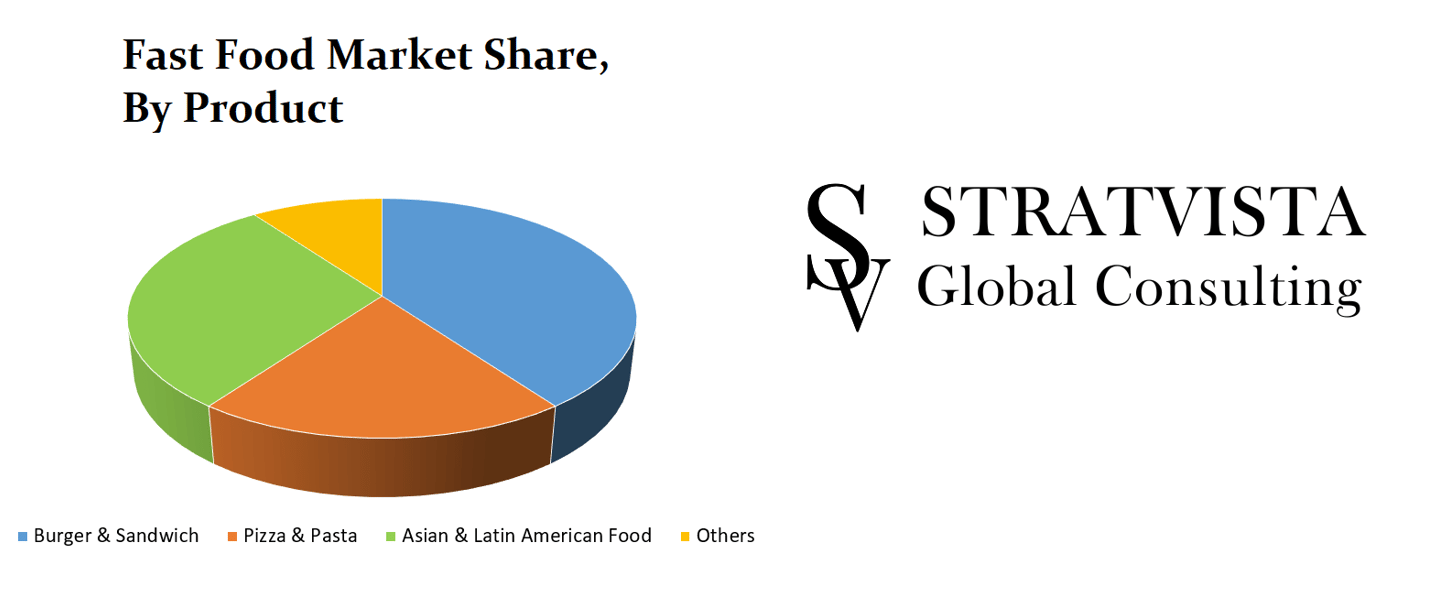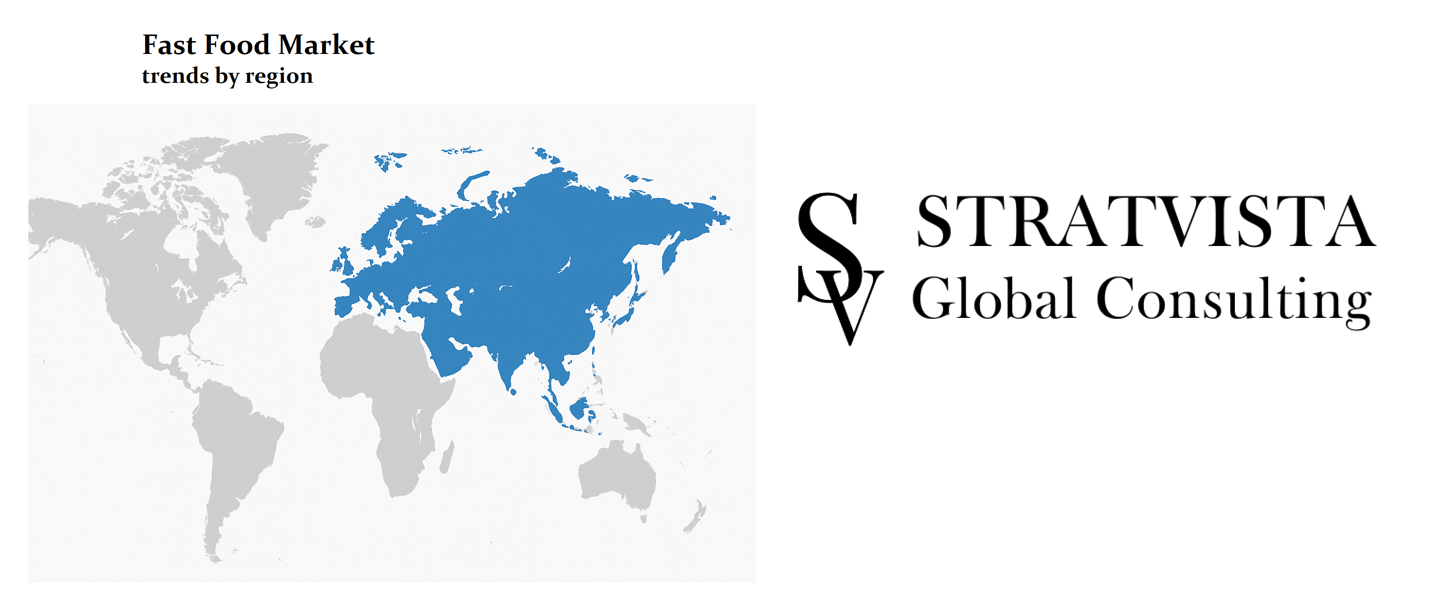Fast Food Market Size, Share, Trend Analysis, By Product Type (Burger & Sandwich, Pizza & Pasta, Asian & Latin American Food, and Others), Service Type (On-Premise and Delivery & Take Away), COVID-19 Impact Analysis, and Forecast
Fully Customizable Report
Choose Market Region
Finalize Table of Contents
Get the Report Delivered in at least 15 days
12 weeks after sales support
Deliverable Format: PDF
Fast Food Market Insights
The global fast food market is experiencing significant growth, driven by changing consumer preferences and an increasing demand for convenience foods. In 2020, the market size was valued at USD xx.xx billion and is projected to reach USD xx.xx billion by 2028, growing at a CAGR of x.x% from 2021 to 2028. Despite the negative impact of the COVID-19 pandemic, which led to a x.x% decline in year-over-year growth in 2020 compared to the 2017-2019 period, the industry is rebounding strongly. The fast food market is expected to return to pre-pandemic levels and witness sustained growth in the coming years.
Europe dominated the global fast food industry in 2020, holding a market share of xx.xx%. This growth can be attributed to a well-established foodservice sector, rising disposable incomes, and an increasing preference for quick and convenient meal options. Additionally, North America and Asia-Pacific are emerging as lucrative markets, driven by the rapid expansion of fast food chains, urbanization, and changing dietary habits.


Starting from USD 2299
The increasing demand for on-the-go snacks, ready-to-eat meals, and cold cuts is fueling the expansion of the fast food market worldwide. The busy lifestyles of millennials and the growing global working population have significantly influenced fast food consumption patterns. Over the years, there has been a steady rise in consumer spending on food prepared outside the home, further supporting market growth.
Additionally, the rise in employment rates globally has contributed to increased spending on convenience foods. The growing preference for online food delivery services, coupled with technological advancements in the food industry, is enhancing accessibility and affordability for consumers.
As the fast food industry continues to evolve, businesses are focusing on menu innovation, healthier alternatives, and digital ordering solutions to attract a larger consumer base. With the increasing penetration of fast food brands in emerging markets, the industry is set for substantial growth in the coming years. The adoption of sustainable packaging and plant-based food options is also expected to shape the future of the global fast food market.
For businesses looking to capitalize on this growing industry, staying ahead of consumer preferences, technological advancements, and market trends will be essential. The fast food market is poised for sustained growth, making it a lucrative sector for investors, franchise owners, and food entrepreneurs.
The fast food market experienced a significant decline in sales due to nationwide lockdown restrictions imposed across major economies. During the first and second quarters of 2020, the fast food industry faced a severe downturn as full-service restaurants, quick-service restaurants (QSRs), and pubs were forced to shut down on-premise dining. Many establishments struggled to sustain operations, and even after reopening, they faced challenges in regaining pre-pandemic sales levels.
With social distancing becoming the new normal, consumers shifted towards online food ordering and takeout services. While many restaurants introduced pick-up and delivery options, the total number of orders remained significantly lower than usual during the first half of 2020. Foot traffic at fast food and casual dining restaurants declined drastically by x%, further impacting the fast food market share across key regions.
Amid the downturn, food delivery services emerged as a major trend in the fast food industry, witnessing a sharp increase in demand. As dine-in restrictions remained in place, consumers increasingly opted for online food delivery platforms, helping restaurants sustain a portion of their revenue. This shift in consumer behavior has led to long-term changes in the fast food industry trends, with a growing emphasis on digital ordering solutions, contactless payments, and mobile app-based food services.
The fast food industry analysis indicates that the market started showing signs of recovery between the fourth quarter of FY 2021 and the first quarter of FY 2022. With the gradual reopening of economies and the easing of restrictions, the fast food market is on track to regain momentum. Businesses are focusing on innovative menu offerings, digital transformation, and enhanced hygiene protocols to attract customers back to physical locations.
As the fast food industry trends continue to evolve, the fast food market share is expected to grow with the expansion of drive-thru services, cloud kitchens, and healthier food options. The increasing consumer preference for on-the-go meals and convenient dining solutions will further accelerate the industry's recovery, making the fast food industry a key sector for investment and expansion opportunities.
Latest Trends
The fast food market has witnessed a transformative shift with the rise of online food delivery services, especially during the global COVID-19 pandemic in 2020. As lockdowns and social distancing measures restricted dine-in options, online food ordering became the lifeline of the fast food industry, allowing foodservice providers to sustain their businesses while ensuring customer access to meals. This trend has now become a permanent fixture in the fast food industry trends, contributing significantly to fast food market share and revenue growth worldwide.
The expansion of e-commerce in the foodservice sector is being fueled by several key factors, including financial growth, rising disposable incomes, increasing internet penetration, and a surge in food consumption. While online food ordering was already prevalent in developed regions, its adoption skyrocketed in developing countries such as India, the Philippines, Indonesia, South Africa, Qatar, Saudi Arabia, the UAE, Singapore, Turkey, Argentina, Brazil, and Chile. The COVID-19 pandemic accelerated this digital transformation, permanently changing the way consumers interact with fast food industry players.
Since the start of the pandemic, online food delivery services have been considered an essential component of the fast food industry, facilitating rapid, error-free, and transparent transactions. Consumers are increasingly shifting from traditional ordering methods to digital platforms, driving higher engagement and brand loyalty. This shift has further solidified fast food industry trends, with businesses investing in mobile apps, AI-powered recommendations, contactless payments, and real-time tracking to enhance the customer experience.
The franchise business model has played a crucial role in the expansion of the fast food market into new territories, particularly in Asia-Pacific and South America. By leveraging the international demand for online meal ordering, major fast food industry players are entering emerging markets, capturing larger consumer bases and increasing overall fast food market share. This expansion aligns with the fast food industry analysis, which predicts strong growth opportunities for both established brands and new market entrants.
As the fast food market continues to evolve, digital innovation and online food delivery services will remain key drivers of growth. The fast food industry trends indicate that businesses adopting advanced technology, AI-driven customer experiences, and sustainable packaging solutions will gain a competitive edge. With consumer demand for convenience, affordability, and speed at an all-time high, the fast food industry is set to thrive, making it a lucrative sector for investment, franchise expansion, and digital transformation.
By capitalizing on these trends, fast food market players can significantly enhance their market share, expand their reach, and drive higher profitability in the ever-evolving fast food industry.
Driving Factors
The fast food market is experiencing rapid growth worldwide, driven by rising disposable incomes, urbanization, and changing consumer preferences. One of the key factors fueling this expansion is the increasing number of dual-income households, which has led to a higher demand for quick and convenient dining options. While well-established brands such as McDonald's, Domino's, Pizza Hut, KFC, and Burger King continue to dominate the industry, the rise of variety food service outlets is further strengthening fast food market share in both developed and emerging economies.
With the growing millennial population, international fast food chains are aggressively expanding into overseas markets, seeking to capitalize on the rising demand for fast food products. The fast food industry analysis highlights key growth drivers such as foreign direct investments, increasing tourism, evolving consumer eating habits, and the proliferation of quick-service restaurants (QSRs). These trends indicate a strong outlook for the fast food industry, with companies focusing on franchise expansion and digital innovation to strengthen their market presence.
The fast food market thrives on speed, efficiency, and convenience, making it an attractive option for millennials and busy professionals. The increasing preference for ready-to-eat meals, takeout options, and home delivery services has reshaped global fast food industry trends, driving higher consumer spending in this sector. With fast food requiring minimal preparation time, its demand is expected to rise significantly, further boosting fast food market share in urban and suburban regions.
According to the United States Department of Agriculture (USDA), the number of quick-service restaurants (QSRs) in the U.S. increased by nearly x% over the last decade, from approximately x establishments in 2000 to over x in 2015. Urban counties in regions such as the Mid-Atlantic, Southeast, and Western states saw an even greater surge, with QSR growth exceeding x% in certain areas. This expansion was largely driven by the emergence of the fast-casual restaurant category, a trend that continues to influence the fast food industry trends and is expected to drive fast food market growth during the forecast period.
The fast food industry analysis predicts strong growth in the coming years, with rising disposable incomes, digital transformation, and increasing franchise investments playing a crucial role. The fast food market is poised for further expansion as companies adapt to consumer preferences, sustainability initiatives, and technological advancements in food ordering. With fast food market share increasing in key global markets, businesses that focus on innovation, affordability, and customer convenience will remain competitive in this evolving landscape.
By leveraging these key fast food industry trends, brands can strengthen their fast food market share, attract a broader consumer base, and maximize profitability in the highly competitive fast food
Restraining Factors
The fast food market has witnessed significant growth, driven by higher disposable incomes, urbanization, home deliveries, and aggressive marketing strategies. With the increasing popularity of ready-to-eat snacks and fast food products, consumers are drawn to international cuisines and convenient dining options. However, despite its rising fast food market share, concerns over the health impact of fast food consumption continue to shape fast food industry trends.
While the fast food industry thrives due to consumer demand for quick, flavorful, and affordable meals, the nutritional drawbacks of junk food consumption remain a key issue. Fast food products typically contain high calorie content but lower levels of minerals, fiber, and water compared to natural foods. This trend is particularly concerning among young adults, who are the primary consumers of fast food market products. The excessive intake of high-fat fast food meals is linked to obesity and obesity-related chronic diseases, posing a long-term risk to public health.
The fast food industry analysis highlights that while fast food market share continues to grow, increasing consumer awareness about health risks may act as a potential restraint to industry expansion. Studies indicate that frequent fast food consumption is a significant risk factor for childhood obesity, which can lead to serious health conditions such as diabetes, heart disease, fatty liver, gall bladder disease, arthritis, and joint disorders. With obesity-related illnesses on the rise, more consumers are becoming conscious of their dietary choices, influencing fast food industry trends toward healthier menu options, plant-based alternatives, and organic fast food offerings.
Despite these concerns, the fast food market remains resilient, with businesses adapting to evolving consumer preferences by offering low-calorie meals, gluten-free options, and healthier ingredient choices. The introduction of nutrition-focused fast food menus is helping brands retain market share while addressing growing health concerns. As fast food industry trends shift toward balanced nutrition and dietary awareness, the fast food industry analysis suggests that companies embracing health-conscious innovations will maintain their competitive edge in this dynamic market.
By recognizing these challenges and adjusting product offerings, businesses in the fast food industry can continue to expand their fast food market share, attract health-conscious consumers, and sustain long-term profitability in the evolving fast food market.
Palm Oil Production Cost Report 2025
By Product Type Analysis
The fast food market is segmented by product type, including burgers & sandwiches, pizza & pasta, Asian & Latin American food, and others. Among these, the burger & sandwich segment dominates the fast food market share, driven by its affordability, convenience, and widespread popularity across all age groups. Leading fast food industry players such as McDonald's and Burger King continue to strengthen their market presence, offering competitive pricing and diverse menu options that appeal to global consumers.
The fast food industry trends indicate that burger & sandwich restaurants hold the largest fast food market share, largely due to cost-effectiveness and accessibility compared to pizza & pasta chains. McDonald's, a global leader in the fast food industry, operates in 119 countries with a mix of company-operated outlets, franchised restaurants, and licensed affiliates. One of the key competitive advantages of burger chains is their breakfast menu offerings, catering to busy consumers seeking convenient meal options. As of 2020, McDonald's operated over 39,000 restaurants worldwide, solidifying its dominance in the fast food market.
Burger King, another major fast food industry player, primarily operates in the U.S. market and focuses on hamburgers, chicken, and specialty menu items at affordable prices. With the widespread availability of these leading fast food chains, the burger & sandwich segment is expected to continue dominating the fast food market share during the forecast period.
The Asian & Latin American food segment holds the second-largest fast food market share, fueled by growing disposable incomes and increasing consumer spending on food. The Asia-Pacific region, home to the majority of the world's population, is experiencing rapid economic growth and urbanization, which is driving demand for diverse and flavorful fast food options. Countries such as India, China, Thailand, Indonesia, Malaysia, Australia, and South Korea are witnessing a surge in fast food consumption, creating significant opportunities for market expansion.
With the fast food industry analysis highlighting a shift towards regional cuisine preferences, major brands are diversifying their menus to cater to local tastes. This trend is expected to boost the growth of the Asian & Latin American food segment, contributing to the overall expansion of the fast food market.
The fast food industry trends indicate continued growth, with consumer preferences evolving toward affordable, convenient, and diverse meal options. As leading fast food brands expand their footprint and introduce innovative menu items, the fast food market share will continue to rise globally. With the dominance of burger & sandwich chains and the growing appeal of Asian & Latin American cuisine, the fast food market is set to experience robust expansion in the coming years.
By Service Type Analysis
The fast food market is segmented by service type, which includes door-to-door delivery, takeaway, and collection services. The rise of quick-service restaurants (QSRs), coffee shops, and fast food outlets has significantly contributed to the fast food market share, catering to the increasing demand for convenience and speed. Popular brands like McDonald’s, Domino’s, KFC, Pizza Hut, Burger King, Starbucks, Subway, and Taco Bell dominate the fast food industry, continually expanding their footprint across new markets.
With household disposable income on the rise, consumers are spending more on hotels, restaurants, and cafes (HoReCa), boosting the growth of the fast food market. This shift is particularly evident among millennials and Gen Z, who prefer quick-service restaurants over traditional dining options due to their affordability, convenience, and diverse menu offerings. The fast food industry analysis indicates that QSRs, food chains, and online ordering services are capitalizing on this trend, driving market expansion.
The fast food industry trends highlight a rapid expansion of international food chains into Tier 2 and Tier 3 cities, tapping into emerging consumer markets. Brands like Domino’s, KFC, Pizza Hut, and McDonald’s are strategically establishing outlets in high-growth regions, aiming to capture the rising demand for fast food. The increasing penetration of food delivery services and online ordering platforms has further fueled this expansion, making fast food more accessible than ever before.
As global fast food consumption continues to rise, the fast food market share is expected to witness significant growth. The increasing adoption of delivery and collection services, coupled with the expansion of fast food chains into new markets, will drive the industry's future. With consumers prioritizing speed, affordability, and variety, the fast food industry is poised for continued success in the coming years.
North America Leads the Global Fast Food Market Share
North America dominated the fast food market in 2020, securing a revenue share of USD xxx.x billion. This region's dominance can be attributed to the increase in dual-income households, rising disposable income levels, and the rapid expansion of fast food chains. The United States remains the largest fast food market, with consumers opting to eat out multiple times a week, driving fast food industry growth. Meanwhile, Mexico is projected to record the highest CAGR from 2021 to 2028, fueled by changing consumer lifestyles, a younger population, and an expanding tourism industry.
Europe Witnesses Steady Growth in the Fast Food Industry
Europe is set to experience consistent growth in the fast food market, driven by the rising number of tourists, evolving consumer preferences, and increased spending on fast foods. The demand for ready-to-make breakfast products is surging due to busier lifestyles, contributing to the expansion of the fast food industry trends in the region. Additionally, Europe remains an attractive market for baked goods and potato-based fast food products, further enhancing fast food market share.
Asia Pacific Emerges as a High-Growth Region in the Fast Food Industry
Asia Pacific is expected to register rapid growth in the fast food industry, primarily due to the increasing adoption of digital food delivery platforms. Countries like India, China, and Japan are witnessing significant expansion of fast food chains, while online retail channels are making fast food more accessible to consumers. The fast food industry analysis suggests that urbanization and rising disposable incomes will continue to drive market expansion in the region.
South America, Middle East, and Africa (MEA) Show Moderate Growth
The fast food industry trends indicate moderate growth in South America and MEA, primarily due to challenges in the food and beverage packaging sector, which affect product convenience and appeal. However, increasing demand for convenience foods is expected to boost the fast food market size, presenting promising opportunities for market expansion in the coming years.
The fast food industry analysis highlights North America, Europe, and Asia Pacific as key regions driving market growth, while emerging markets in South America and MEA hold future potential. With changing consumer preferences, digital transformation in food delivery, and the expansion of international fast food chains, the global fast food market share is expected to witness steady growth throughout the forecast period.
Key Industry Players
The fast food market in India is witnessing a major transformation as Wendy’s Company, a leading quick-service restaurant chain, partners with cloud kitchen giant Rebel Foods to establish 250 cloud kitchens across the country. Rebel Foods, known for operating brands like Faasos, Behrouz Biryani, and Mandarin Oak, will collaborate with Sierra Nevada Restaurants, Wendy’s Indian master franchisee, to develop and manage these cloud kitchen operations.
This strategic move underscores the fast food industry trends, where brands are increasingly leveraging cloud kitchens and digital food delivery to expand their reach. The partnership between Wendy’s and Rebel Foods is one of the largest of its kind for Wendy’s in any global fast food market, reflecting the company’s commitment to strengthening its presence in India’s booming foodservice industry.
With the fast food industry analysis highlighting India as a high-growth market, Wendy’s expansion through cloud kitchens will enhance its fast food market share while catering to the rising demand for convenient, on-demand food services. The rapid growth of online food delivery platforms and changing consumer habits make this a strategic and profitable move for the brand.
As global fast food industry trends shift towards delivery-based business models, Wendy’s partnership with Rebel Foods and Sierra Nevada Restaurants is expected to play a pivotal role in reshaping the fast food industry in India, further fueling market competition and innovation.
Key Fast Food Companies:
Here are the top companies shaping the fast food market, holding the largest market share and influencing global industry trends.
McDonald's (Minnesota, U.S.)
Burger King (Florida, U.S.)
Wendy's (Ohio, U.S.)
Domino's (Michigan, U.S.)
Pizza Hut (Texas, U.S.)
Papa John's International, Inc. (Kentucky, U.S.)
Little Caesars (Michigan, U.S.)
Chipotle Mexican Grill (California, U.S.)
Dunkin (Massachusetts, U.S.)
Wallace, Fujian Food Co., Ltd. (Fujian, China)
Recent Developments
In October 2021, Burger King introduced Impossible Nuggets, a plant-based alternative catering to the rising demand for meat-free options, along with the nationwide release of Ghost Pepper Nuggets as a limited-time offer. These additions reflect the latest fast food industry trends, where brands are focusing on menu innovation to attract a broader customer base.
In September 2021, Papa John’s International strengthened its fast food market share by signing a franchisee development agreement with Sun Holdings to open 100 new stores across Texas by 2029. This expansion highlights the growing demand for quick-service restaurants (QSRs) and the fast food industry's growth potential in key markets. As competition intensifies, leading brands continue to invest in franchise expansion, menu diversification, and consumer-driven innovations, driving significant growth in the global fast food industry.
How Our Chocolate Market Analysis Report Helps Your Business Grow?
Our Fast Food Market Intelligence Report provides critical insights for CEOs, COOs, and Procurement Managers, helping them make informed decisions, optimize supply chains, and stay ahead of evolving market trends. Here’s how this report can drive growth and profitability in your fast food business:
Key Benefits of Our Fast Food Market Report:
✅ Comprehensive Market Insights – Understand the fast food industry’s market size, growth projections, key players, and emerging trends to stay competitive.
✅Strategic Procurement & Supply Chain Optimization – Optimize supplier selection, ingredient sourcing, pricing strategies, and logistics management to improve cost efficiency.
✅ Consumer Trends & Demand Analysis – Stay ahead of changing consumer preferences, including healthier menu options, plant-based fast food, and digital ordering trends.
✅ Competitive Benchmarking – Analyze leading fast food brands, pricing models, franchise strategies, and innovation trends to strengthen your market position.
✅ Regional Market Growth & Expansion – Identify high-growth regions, emerging markets, and investment opportunities for franchise expansion and market entry.
✅ Regulatory & Compliance Insights – Stay updated on food safety regulations, labeling laws, and labor policies impacting the fast food industry.
✅ Technology & Innovation Trends – Leverage advancements in AI-driven customer analytics, automation in fast food service, and sustainable packaging solutions.
What Else We Provide to Help Your Business Grow Globally:
🔹 Customized Market Intelligence – Tailored insights specific to your business needs, including franchise expansion strategies, partnership opportunities, and risk analysis.
🔹 Supply Chain Efficiency – Enhance operations with logistics insights, supplier risk assessments, and cost-saving strategies.
🔹 Consumer Behavior & Digital Trends – Understand regional consumer habits, online food delivery growth, and app-based ordering trends for targeted marketing.
🔹 Investment & Expansion Strategies – Identify M&A opportunities, new product development areas, and competitive positioning tactics to scale your fast food business.
🔹 Sustainability & ESG Trends – Adapt to evolving industry demands with eco-friendly packaging, ethical ingredient sourcing, and energy-efficient operations.
Our report equips fast food industry leaders with data-driven insights to enhance profitability, drive innovation, and expand their business in a rapidly evolving market.
Stay Ahead in the Fast Food Industry!




Qualitative Analysis
Industry overview: This section provides a broad understanding of the industry, including its history, current status, and expected future developments. It outlines the industry structure, key segments, major players, and the overall economic impact.
Industry trends: Industry trends highlight ongoing changes and evolving patterns within the sector. These could include:
Technological advancements
Regulatory changes (new laws or compliance requirements)
Consumer preferences (shifts in demand and buying behavior)
Sustainability initiatives (green energy, eco-friendly products)
Market drivers and restraints:
Market Drivers: Factors that boost industry growth, such as increasing demand, government support, technological advancements, or cost reductions.
Market Restraints: Challenges that hinder growth, including high costs, regulatory hurdles, market saturation, or supply chain disruptions.
Market size: Market size refers to the total value or volume of the industry, typically measured in revenue (USD) or units sold. It includes:
Current market valuation
Historical data and growth patterns
Future projections (CAGR, expected growth over a specific period)
Growth prospects: This section discusses potential areas of expansion and future opportunities, including:
Emerging markets with high demand
New product innovations
Strategic partnerships and mergers
Untapped customer segments
Porter’s analysis: A strategic framework that evaluates competitive forces in an industry:
Threat of New Entrants – How easy it is for new companies to enter the market.
Bargaining Power of Suppliers – Influence of suppliers on pricing and supply.
Bargaining Power of Buyers – Influence of customers on pricing and demand.
Threat of Substitutes – Availability of alternative products or services.
Industry Rivalry – Competitive intensity among existing players.
PESTEL analysis: A macro-environmental analysis that examines external factors affecting the industry
Political (government policies, trade regulations)
Economic (inflation, exchange rates, GDP growth)
Social (consumer behavior, demographics, lifestyle changes)
Technological (R&D, digital transformation)
Environmental (sustainability, climate policies)
Legal (labor laws, compliance, industry regulations)
Key market opportunities prioritized: Identifies the most lucrative opportunities within the industry, ranked based on factors such as market demand, profitability, competition, and feasibility. It helps businesses focus on high-potential areas for investment.
Competitive landscape: A detailed analysis of the major industry players, including
Market share analysis
Key differentiators (pricing, technology, customer service, etc.)
Strategies for market positioning
Competitive strengths and weaknesses
Company overview: A summary of key companies in the industry, including
Corporate structure
Business operations and product offerings
Geographical presence
Financial performance: A company’s financial health assessment, covering
Revenue, profit margins, and cash flow
Debt levels and investment trends
Year-over-year (YoY) growth comparison
Product benchmarking: A comparative analysis of key products offered by major competitors, focusing on
Features and specifications
Pricing strategies
Performance metrics
Market positioning
Latest strategic developments: Covers recent business moves made by key companies, including
Mergers and acquisitions (M&A)
Product launches and innovations
Partnerships and collaborations
Investment and expansion plans
Regulatory approvals
Quantitative Analysis
Market size, estimates and forecast
Market estimates and forecast for product segments
Regional market size and forecast for product segments
Market estimates and forecast for application segments
Regional market size and forecast for application segments
Company financial performance
Segmentation
Regional Insights


Management Consulting
© 2025 StratVista Global Consulting. All rights reserved.
Navigating Success with Strategy & Vision
Subscribe to Our Newsletter
Get updated with the latest commodity prices and trends


StratVista
Global
Consulting
